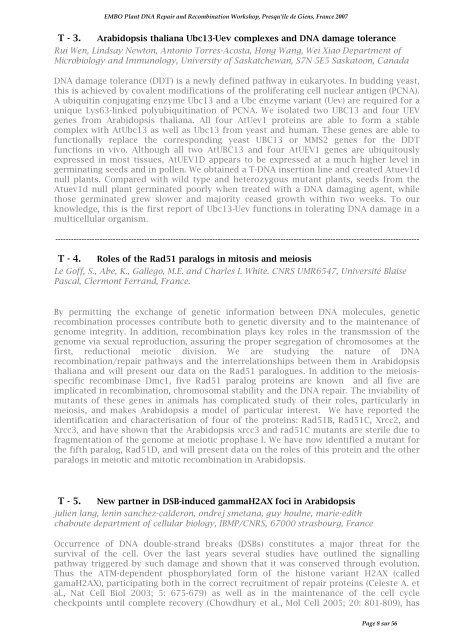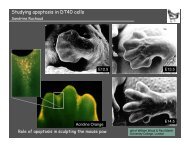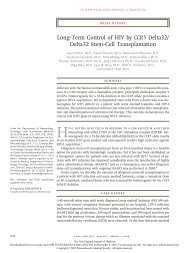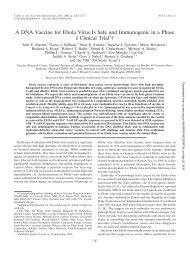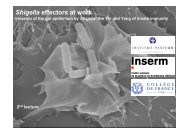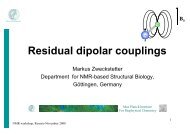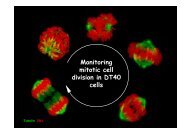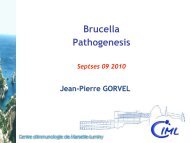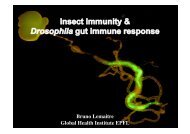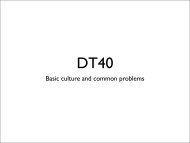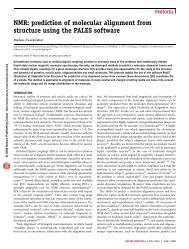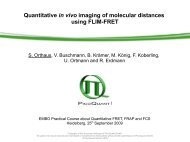pdf file - Events - EMBO
pdf file - Events - EMBO
pdf file - Events - EMBO
You also want an ePaper? Increase the reach of your titles
YUMPU automatically turns print PDFs into web optimized ePapers that Google loves.
<strong>EMBO</strong> Plant DNA Repair and Recombination Workshop, Presqu'île de Giens, France 2007<br />
T - 3. Arabidopsis thaliana Ubc13-Uev complexes and DNA damage tolerance<br />
Rui Wen, Lindsay Newton, Antonio Torres-Acosta, Hong Wang, Wei Xiao Department of<br />
Microbiology and Immunology, University of Saskatchewan, S7N 5E5 Saskatoon, Canada<br />
DNA damage tolerance (DDT) is a newly defined pathway in eukaryotes. In budding yeast,<br />
this is achieved by covalent modifications of the proliferating cell nuclear antigen (PCNA).<br />
A ubiquitin conjugating enzyme Ubc13 and a Ubc enzyme variant (Uev) are required for a<br />
unique Lys63-linked polyubiquitination of PCNA. We isolated two UBC13 and four UEV<br />
genes from Arabidopsis thaliana. All four AtUev1 proteins are able to form a stable<br />
complex with AtUbc13 as well as Ubc13 from yeast and human. These genes are able to<br />
functionally replace the corresponding yeast UBC13 or MMS2 genes for the DDT<br />
functions in vivo. Although all two AtUBC13 and four AtUEV1 genes are ubiquitously<br />
expressed in most tissues, AtUEV1D appears to be expressed at a much higher level in<br />
germinating seeds and in pollen. We obtained a T-DNA insertion line and created Atuev1d<br />
null plants. Compared with wild type and heterozygous mutant plants, seeds from the<br />
Atuev1d null plant germinated poorly when treated with a DNA damaging agent, while<br />
those germinated grew slower and majority ceased growth within two weeks. To our<br />
knowledge, this is the first report of Ubc13-Uev functions in tolerating DNA damage in a<br />
multicellular organism.<br />
-------------------------------------------------------------------------------------------------------------------------------------------<br />
T - 4. Roles of the Rad51 paralogs in mitosis and meiosis<br />
Le Goff, S., Abe, K., Gallego, M.E. and Charles I. White. CNRS UMR6547, Université Blaise<br />
Pascal, Clermont Ferrand, France.<br />
By permitting the exchange of genetic information between DNA molecules, genetic<br />
recombination processes contribute both to genetic diversity and to the maintenance of<br />
genome integrity. In addition, recombination plays key roles in the transmssion of the<br />
genome via sexual reproduction, assuring the proper segregation of chromosomes at the<br />
first, reductional meiotic division. We are studying the nature of DNA<br />
recombination/repair pathways and the interrelationships between them in Arabidopsis<br />
thaliana and will present our data on the Rad51 paralogues. In addition to the meiosisspecific<br />
recombinase Dmc1, five Rad51 paralog proteins are known and all five are<br />
implicated in recombination, chromosomal stability and the DNA repair. The inviability of<br />
mutants of these genes in animals has complicated study of their roles, particularly in<br />
meiosis, and makes Arabidopsis a model of particular interest. We have reported the<br />
identification and characterisation of four of the proteins: Rad51B, Rad51C, Xrcc2, and<br />
Xrcc3, and have shown that the Arabidopsis xrcc3 and rad51C mutants are sterile due to<br />
fragmentation of the genome at meiotic prophase I. We have now identified a mutant for<br />
the fifth paralog, Rad51D, and will present data on the roles of this protein and the other<br />
paralogs in meiotic and mitotic recombination in Arabidopsis.<br />
T - 5. New partner in DSB-induced gammaH2AX foci in Arabidopsis<br />
julien lang, lenin sanchez-calderon, ondrej smetana, guy houlne, marie-edith<br />
chaboute department of cellular biology, IBMP/CNRS, 67000 strasbourg, France<br />
Occurrence of DNA double-strand breaks (DSBs) constitutes a major threat for the<br />
survival of the cell. Over the last years several studies have outlined the signalling<br />
pathway triggered by such damage and shown that it was conserved through evolution.<br />
Thus the ATM-dependent phosphorylated form of the histone variant H2AX (called<br />
gamaH2AX), participating both in the correct recruitment of repair proteins (Celeste A. et<br />
al., Nat Cell Biol 2003; 5: 675-679) as well as in the maintenance of the cell cycle<br />
checkpoints until complete recovery (Chowdhury et al., Mol Cell 2005; 20: 801-809), has<br />
Page 8 sur 56


